Fishing Rod

Twilight Princess took the concept to another level entirely, as the rod itself became an usable item anywhere in the field, letting Link fish in more than just a dedicated pond, and the addition of new lure types to equip allowed a degree of strategy in attempting to catch different fish. There is more to the fishing rod than meets the eye, however, as it seems to have an almost hypnotic effect on the Dark Lord Ganondorf himself…
- Az
Ball and Chain
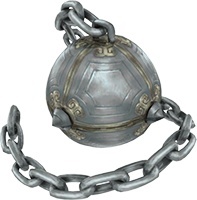 The idea of a "Ball and Chain" is usually negative, but not in this series. Ironically found in Snowpeak Ruins, the Ball and Chain gives Link the ability to destroy ice, and packs a punch, in general - but at a cost.
The idea of a "Ball and Chain" is usually negative, but not in this series. Ironically found in Snowpeak Ruins, the Ball and Chain gives Link the ability to destroy ice, and packs a punch, in general - but at a cost.
Wailing the Ball and Chain means Link is greatly slowed by the item's weight, and players must take this into account when wielding the hefty weapon, infusing strategy into an otherwise mundane piece of equipment.
- David
Bow-Wow
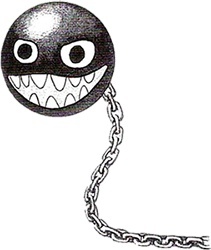 Bow-Wow might seem a strange choice for an item. It's only used once in one game - Link's Awakening. It's really only there to open up one dungeon. In fact, it's barely an item at all. Why does it deserve a place in this list, then?
Bow-Wow might seem a strange choice for an item. It's only used once in one game - Link's Awakening. It's really only there to open up one dungeon. In fact, it's barely an item at all. Why does it deserve a place in this list, then?
Because it's awesome. It's a vicious destructive beast you get to take for a walk, constantly attacking everything around you. It's both empowering, yet also somewhat scary, given what's being controlled. Perhaps more significantly, Bow-Wow is also a great example of narrative and gameplay working as one. This isn't an item on a pedestal for Link to pick up and use in spots clearly designed for that item. This is just a creature he takes for a walk... and as a side effect, it helps open up new areas by eating what's in his way. More like this, please!
- Thomas
Roc's Feather
 Series hero Link has always been a fairly athletic chap, running through grass, climbing up mountains and sailing across the world, but one of his shortcomings over the years would perhaps be his inability to jump at will in most of the Zelda games. The top-down Zelda tales on Game Boy were designed with a handful of holes in the ground that proved a cumbersome obstacle. Link would simply fall to his demise briefly, and then respawn to attempt it once again.
Series hero Link has always been a fairly athletic chap, running through grass, climbing up mountains and sailing across the world, but one of his shortcomings over the years would perhaps be his inability to jump at will in most of the Zelda games. The top-down Zelda tales on Game Boy were designed with a handful of holes in the ground that proved a cumbersome obstacle. Link would simply fall to his demise briefly, and then respawn to attempt it once again.
In Link's Awakening, however, there was a solution - Roc's Feather, an item that allows Link to be unconfined from the benefits of gravity and jump across single holes. Our hero could combine the feather with running shoes, like the Pegasus Boots, to leap over a handful of holes with ease. The dynamic changed the way you would approach Zelda puzzles, with the jumping mechanic becoming key in quite a few moments in the game and the Oracle series.
- Jorge
Lens of Truth
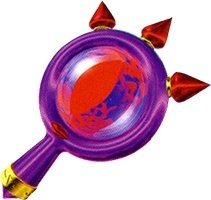 One of the non-combat items in the series, the Lens of Truth shows hidden passageways and enemies at the cost of magic. Coming from the Bottom of the Well in Ocarina of Time, an air of mystery surrounds the item, which is meant to show the hidden world underlying Hyrule.
One of the non-combat items in the series, the Lens of Truth shows hidden passageways and enemies at the cost of magic. Coming from the Bottom of the Well in Ocarina of Time, an air of mystery surrounds the item, which is meant to show the hidden world underlying Hyrule.
Those who once believed that the Triforce was hidden away somewhere in Ocarina of Time will likely recall scouring every inch of the game with the lens, and while it was a fruitless search, it's one that sticks out in many players' minds.
- David
Ocarina
 There couldn't be a Legend of Zelda items feature without mentioning the musical focus throughout the series. From harps to drums, guitars to Howling Stones, there has been a tradition of granting the Hero with a little melody or two to play. The key instrument that's been ingrained into the series mark-up has to be the ocarina, a mystical item that has the potential to alter the landscape and the flow of time itself.
There couldn't be a Legend of Zelda items feature without mentioning the musical focus throughout the series. From harps to drums, guitars to Howling Stones, there has been a tradition of granting the Hero with a little melody or two to play. The key instrument that's been ingrained into the series mark-up has to be the ocarina, a mystical item that has the potential to alter the landscape and the flow of time itself.
The ocarina has appeared in a handful of Zelda titles in some form, but the most prominent appearance has to be in Ocarina of Time, where it became so intrinsically woven into the plot, that it had the honour of sitting prominently in the game's title. Here, Link can use it to solve various puzzles, change the time of day and even warp across the land in a similar way to A Link to the Past. The time mechanic becomes even stronger in Majora's Mask, where the Ocarina of Time can speed up or even slow down time to a halt; a useful feature when there's only three days left to survive!
- Jorge
Fire Rod
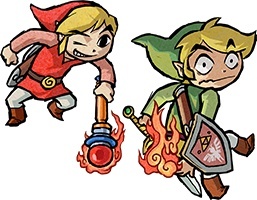 There are many great Rods out there - Rod Stewart, Rodney from Only Fools and Horses, for instance - but special mention has to go to the Fire Rod. No, this is not some medical terminology for that burning sensation some poor folk get down below... Instead, it is one of the most useful tools in the world of The Legend of Zelda, with hero Link able to bring light to a darkened room, cinch enemies, and even melt ice. There are rumours of Link using the Fire Rod with a marshmallow-filled stick, but they are unsubstantiated, and, of course, he refutes it vehemently. After all, he has a reputation to keep up!
There are many great Rods out there - Rod Stewart, Rodney from Only Fools and Horses, for instance - but special mention has to go to the Fire Rod. No, this is not some medical terminology for that burning sensation some poor folk get down below... Instead, it is one of the most useful tools in the world of The Legend of Zelda, with hero Link able to bring light to a darkened room, cinch enemies, and even melt ice. There are rumours of Link using the Fire Rod with a marshmallow-filled stick, but they are unsubstantiated, and, of course, he refutes it vehemently. After all, he has a reputation to keep up!
All joking aside, Link loves to vary things up, and has been seen not only sporting a Rod of the Fire variety, but an Ice, Magic, Sand, and even Tornado Rod. As long as he has something firm in his hands, he's always a happy chappy...
- Adam
Bow
 Another of Link's longest-running inventory items, the bow and arrow had an interesting mechanic in the first game: the bow lasts forever, but arrows do not, costing one Rupee each. This was long before the times of cutting fields of grass and finding money aplenty, so players had to think before firing off an arrow, as the cost could quickly add up. Given the item's range and damage output, it was often worth it - except, of course, when the arrow misses.
Another of Link's longest-running inventory items, the bow and arrow had an interesting mechanic in the first game: the bow lasts forever, but arrows do not, costing one Rupee each. This was long before the times of cutting fields of grass and finding money aplenty, so players had to think before firing off an arrow, as the cost could quickly add up. Given the item's range and damage output, it was often worth it - except, of course, when the arrow misses.
These days, Link has Fire, Ice, and Light arrows at his disposal, and the bow and arrow have even become somewhat of Princess Zelda's signature weapon, with the Light Arrow being her Final Smash in the Smash Bros. series and her weapon of choice to put Ganondorf in his place during The Wind Waker's grand finale.
- David
Hammer

The hammer debuted in Zelda II: The Adventure of Link as one of very few ways to interact with the world map, allowing players to take shortcuts, find optional items, and knock down entire swathes of forests, but it's perhaps best known for its usage in A Link to the Past, where, in addition to opening up parts of the world to further exploration, it also crippled otherwise invulnerable enemies. Of course, it's hard to say "No" to another game of Whac-A-Mole with Volvagia, too.
- Aria
Spinner
 The Zelda games, structurally, are Metroidvanias, with many of the items thus specifically designed to let the player get to previously inaccessible areas of the landscape. With so many games in the series, and so many of the more obvious forms of locomotion covered, the designers must constantly ask the question of how to achieve this. What new obstacles should Link have to overcome, and what new device should help him overcome it?
The Zelda games, structurally, are Metroidvanias, with many of the items thus specifically designed to let the player get to previously inaccessible areas of the landscape. With so many games in the series, and so many of the more obvious forms of locomotion covered, the designers must constantly ask the question of how to achieve this. What new obstacles should Link have to overcome, and what new device should help him overcome it?
The Spinner is possibly the strangest answer to that question. Leap on top of a strange cog-like spinning top that then locks into various rails about the landscape. Grind around the rails to reach new locations, occasionally switching from rail to rail at critical moments. It's ridiculous, with the rails explicitly something set up for the player with little in-universe reason to exist, yet it is fun. It's truly unique. And at the end of the day, it will put a smile on your face - when you're not pulling your hair out, that is.
- Thomas
Master Sword

The recurring blade was originally forged by the goddess Hylia and went by a more divine name in Skyward Sword: the Goddess Sword. Bathed in the energy of three Sacred Flames that are scattered across the land of Hyrule, the Master Sword is a pretty strong beast; one that can repel evil and defeat the power-hungry Ganondorf. The origins and tales of this particular weapon have been distorted throughout the Zelda timeline, but its intentions and the "chosen" user have remained consistent - a hero who has slugged it out through great trials that test courage, wisdom and power.
Perhaps the most memorable moment for the Master Sword would be its role in Ocarina of Time, where its power is used as a key to allow Link to travel through time.
- Jorge
Mirror Shield
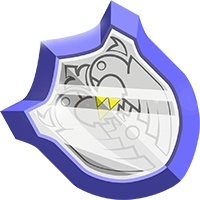 Similar to Perseus defeating Medusa in Greek mythology, the Mirror Shield allows for more than just outright defence of attacks and projectiles. Although in some games it does block strong laser beams that otherwise shoot right through Link, can turn beams of its own back on enemies, and destroys undead monsters in certain variations, its most unique feature is the ability to reflect light sources onto other areas of a room.
Similar to Perseus defeating Medusa in Greek mythology, the Mirror Shield allows for more than just outright defence of attacks and projectiles. Although in some games it does block strong laser beams that otherwise shoot right through Link, can turn beams of its own back on enemies, and destroys undead monsters in certain variations, its most unique feature is the ability to reflect light sources onto other areas of a room.
This mechanic paved the way for a host of brain-teasing puzzles, as reflecting light to destroy statues and activate switches became central themes of a number of dungeons. Furthermore, it plays a key role in one of the most fun boss battles featuring a particular pair of witches in Ocarina of Time, absorbing and blasting back charged fire and ice energy with powerful effect.
- Az
Boomerang
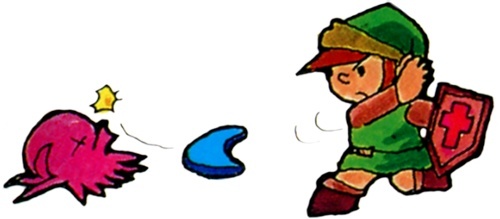
The boomerang has seen many upgrades, with the first being a boost to range in The Legend of Zelda, going all the way up to the Gale Boomerang, which adds the power of wind to help Link put the spin on his enemies or control certain fans. Sure, the mechanics aren't exactly realistic, but targeting a series of enemies or environment pieces and watching the boomerang do its thing will always be fun.
- David
Double Clawshots

While they lack the fun of the swinging mechanic found in The Wind Waker's Grappling Hook - at least, so far - the Double Clawshots bring a sense of power and wonder in their own right, and will hopefully become a series staple moving forward.
- David
Bombchu
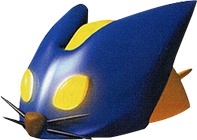 Across the entire series, range has been an important factor. From the boomerangs and arrows of the first game, up through the Hookshot in A Link to the Past, the Zelda games have always existed in a world that forces players to think beyond a limited radius around their player character.
Across the entire series, range has been an important factor. From the boomerangs and arrows of the first game, up through the Hookshot in A Link to the Past, the Zelda games have always existed in a world that forces players to think beyond a limited radius around their player character.
The Bombchu in Ocarina of Time took this concept to a new level. Being the first 3D Zelda game, it was probably a no-brainer to include the classic boomerang and bow and arrow, but where those items can simply be thrown across space, the Bombchu forces players to strategise, taking into account walls and surfaces. It adds a puzzle element to the three-dimensional item usage space, and the games in which it appears are all better off for it. And, when all else fails, it can blow up enemies and cracked walls just like the classic bombs across the series.
- David

 Sign In
Sign In 23.02.2016
23.02.2016  Marzeee
Marzeee 
 Link to this post:
Link to this post: 
 Subscribe to this topic
Subscribe to this topic Features
Features






 Top
Top

